If you buy through our links, we may earn an affiliate commission. This supports our mission to get more people active and outside.Learn about Outside Online's affiliate link policy
The Best Track Spikes of 2025, Reviewed

Today's track spikes offer performance-enhancing cushion and bounce as well as ground-gripping traction. (Photo: Cory Smith)
Lacing up your spikes before a race or tough workout brings a surge of anticipation and excitement—your body instinctively knows it’s go time. Whether you’re a sprinter exploding out of the blocks, a mid-distance runner balancing speed and endurance, or a distance specialist grinding through the final laps, the right pair of spikes can help you perform at your best.
With today’s advancements in lightweight materials, carbon-fiber plates, and energy-returning foams, track spikes are faster and more specialized than ever. If you want to compete at your best in track and field, spikes are essential—and today’s are better than ever.
Update March 2025: We’ve replaced seven spikes with updated models from Nike, Saucony, Asics, New Balance, Puma, and Hoka, and removed two spikes from the list.
Here are our top picks from spring 2025’s options, what you need to know about choosing a track spike, and the technology behind today’s superspikes.
At A Glance
Best Distance Spikes
- Best All-Around: Nike Dragonfly 2 ($160)
- Runner Up All-Around: Saucony Terminal VT ($150)
- Most Flexible: Brooks Hyperion Elite LD ($150)
- Most Cushioned: Hoka Cielo FLYX ($180)
- For Wide Feet: Asics Metaspeed LD 2 ($250)
Best Middle-Distance Spikes
- Best All-Around: Nike Victory 2 ($190)
- Runner Up All-Around: New Balance FuelCell SuperComp MD-X v3 ($160)
- Lightest: Saucony Endorphin Cheetah ($180)
- For Forefoot Runners: Brooks Hyperion Elite MD ($180)
- For Narrow Feet: Asics MetaSpeed MD ($250)
Best Sprint Spikes
- Best All-Around: Nike Max Fly 2 ($190)
- Most Aggressive: Puma evoSPEED Sprint Nitro 2 ($250)
- Most Versatile: Diadora Velocita Carbon ($290)
- Best Ground Connection: Asics Metaspeed SP ($250)
Best Value Spikes
- Distance: Nike Zoom Rival Distance ($75)
- Middle-Distance: Hoka Crescendo MD 2 ($80)
- Sprint: Under Armour Kick Sprint 4 ($70)
The Best Distance Track Spikes
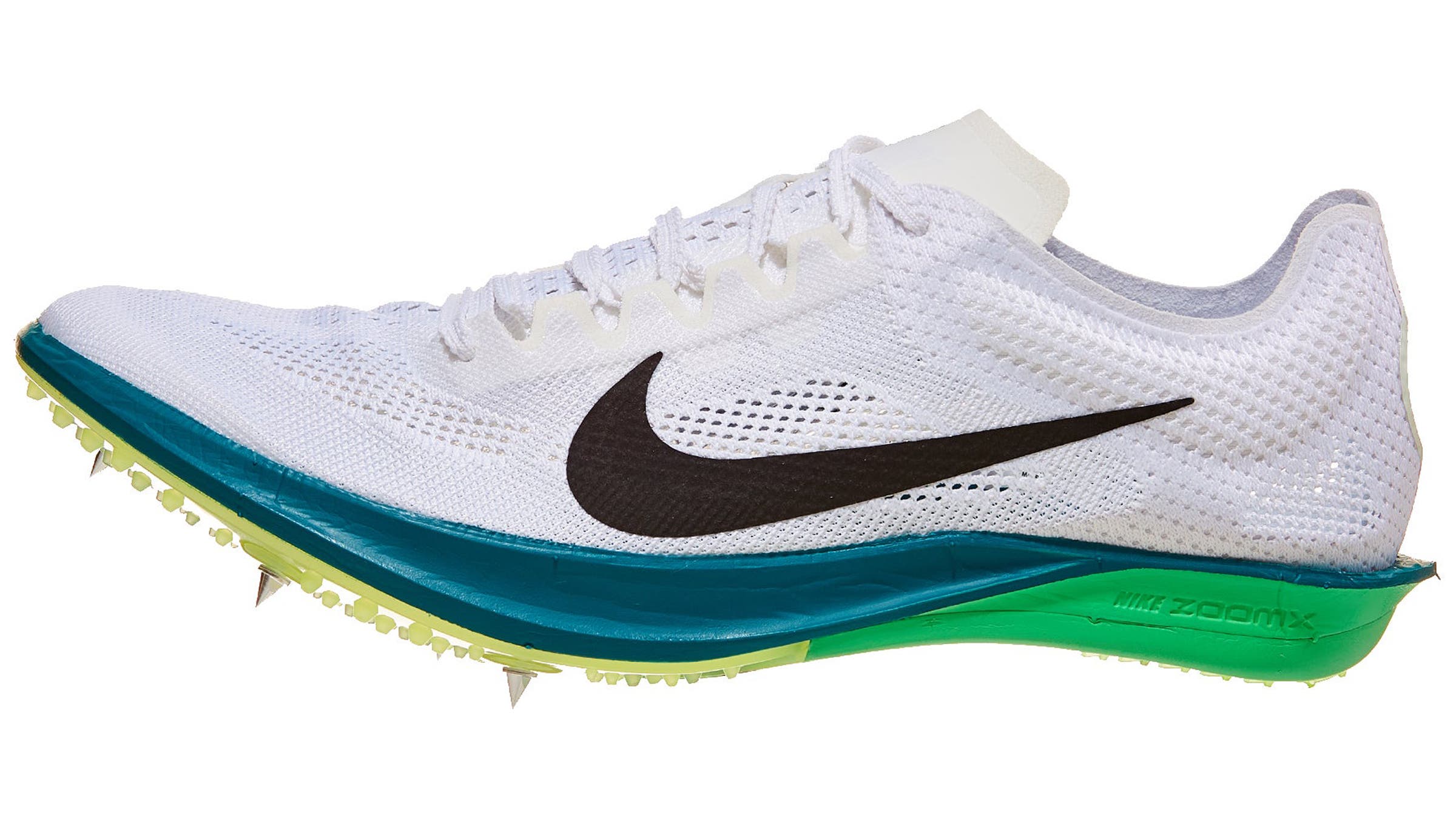
Best All-Around
Nike Dragonfly 2
Ideal Events: 800 to 10,000 meters
Weight: 4.8 ounces
Spike Pins: 4
For the second year in a row, the Nike Dragonfly 2 has earned our top billing as the best all-around distance track spike you can buy. One tester praised it as “the most universally good spike on the market.” The midsole remains Nike’s highest-energy-returning foam, ZoomX, while the embedded plate got lighter and more responsive. Testers noticed the difference, reporting that it felt “softer than its previous version” with “a noticeable gain in energy return.” Other subtle updates were also appreciated, like a slightly wider midfoot and forefoot, added support under the big toe and heel counter, and two fewer spikes. None of the changes affected the smooth and efficient transitions delivered by the moderately aggressive forefoot rocker. The engineered mesh provides such a secure, conforming fit that one tester dubbed it the most comfortable spike he’s worn. For a slightly lighter version that features permanent spikes try the Nike Dragonfly 2 Elite.

Runner Up All-Around
Saucony Terminal VT
Ideal Events: 5,000 to 10,000 meters
Weight: 3.7 ounces
Spike Pins: 4
At sub 4 ounces, the Saucony Terminal VT came in as the lightest spike we tested. It is also, surprisingly, the most cushioned. Best suited for longer-distance events, the Terminal VT relies on an embedded, slightly flexible Pebax spike plate (instead of a rigid carbon fiber one) for structure and stiffness. “It doesn’t force you up on your toes, but there’s enough flexibility and midfoot to forefoot roll to help promote an efficient stride,” said one tester. The light, bouncy PEBA-based midsole foam underfoot felt more protective and cushioned than most spikes we tested, reminding us somewhat of a road racing flat. Testers noted the comfort of the thin see-through mesh upper, but said it fit on the smaller side. If you prefer an ultra-lightweight track spike that runs more like a thinly cushioned road racing flat (in contrast to the forward sling-shot action of carbon fiber-plated spikes), these are for you.

Most Flexible
Brooks Hyperion Elite LD
Ideal Events: 1500 to 10,000 meters
Weight: 4.8 ounces
Spike Pins: 6
Offering the most underfoot flexibility of all the distance spikes listed, yet still providing a springy lever, the Brooks Hyperion Elite LD emerged as our go-to spike for long distance races and track workouts when seeking a more sensitive experience. The semi-flexible carbon fiber plate with ample nitrogen-injected midsole cushioning delivered a ride both protectively cushioned and responsively speedy. “It keeps my legs from getting beat up too badly, while still having the backbone to run fast and aggressively when needed,” noted one tester. The consensus among our entire testing team was the longer the event the better the Hyperion Elite LD performed, with one tester noting they “really start to shine in the 5k.”
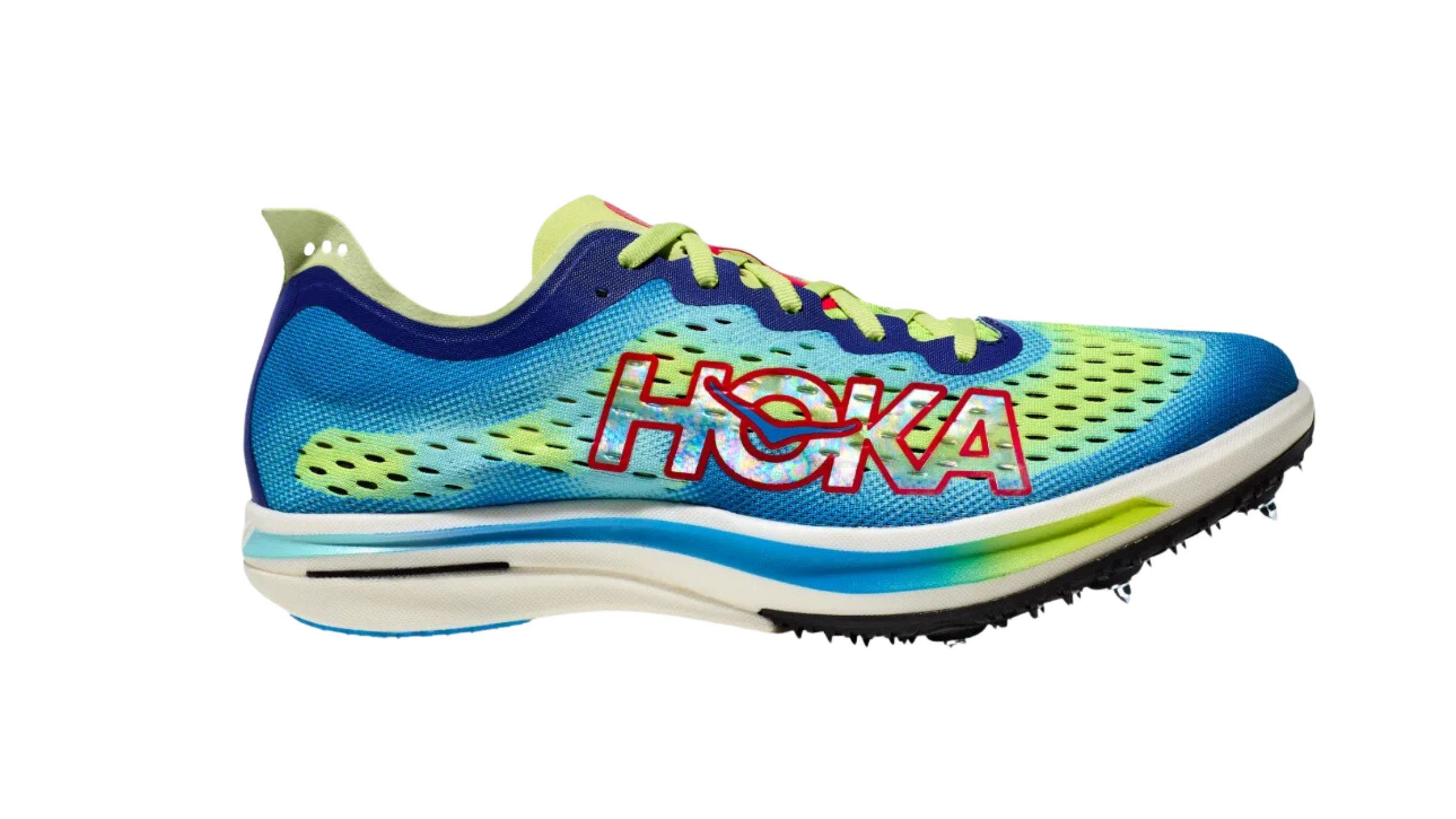
Most Cushioned
Hoka Cielo FLYX
Ideal Events: 3000 to 10,000 meters
Weight: 5.8 ounces
Spike Pins: 6
With an impressive 25 millimeters of high-energy PEBA midsole (making it competition illegal as per World Athletics shoe regulations rule), the Hoka Cielo FLYX stands out as the most cushioned track spike on the market. Testers appreciated the abundant cushioning during long track workouts and extended track races such as the 5k and 10k, reporting that they felt less strain on the legs compared to traditional thin-soled spikes. Still, even with all that foam underfoot, one tester said, “It’s probably the fastest pure distance spike I tested…it was shocking to see that I was faster and running with lower perceived effort compared to other spikes tested.” The shoe features a robust composite plate that serves dual roles as a spike plate and a biomechanical lever. Its stiff, aggressive, rockered profile delivers a prescriptive yet smooth rolling motion. However, unlocking its full potential requires a touch of power. One tester noted, “the more I ramped up my speed, the more the spikes gave back.”
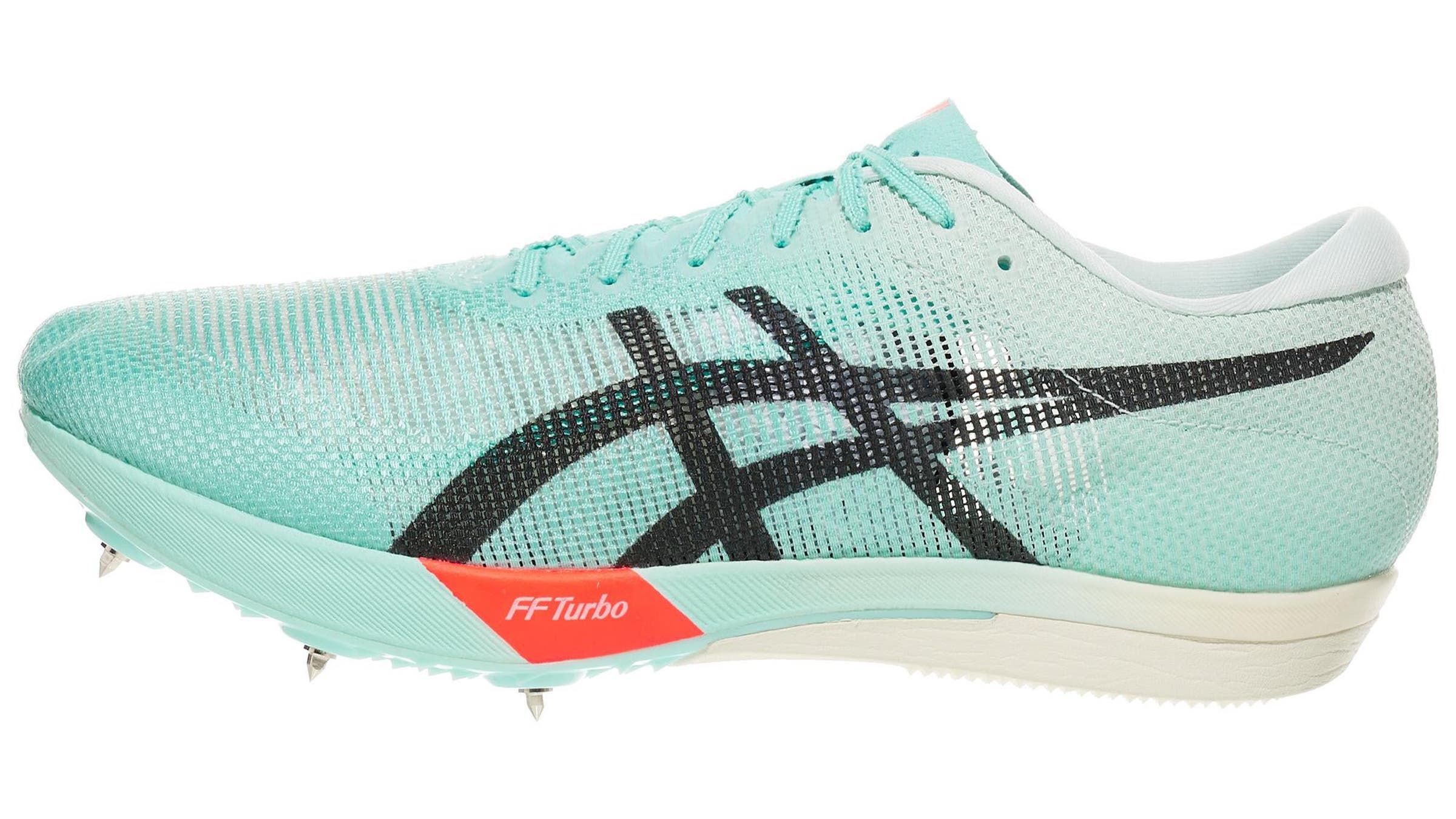
For Wide Feet
Asics Metaspeed LD 2
Ideal Events: 5,000 and 10,000 meters
Weight: 5.6 ounces
Spike Pins: 6
Fitting more like a road running shoe, the Asics Metaspeed LD 2 offers a slightly roomier toe box compared to most spikes, making it a more comfortable option for athletes with wider feet. Some testers praised the ample forefoot fit, while others felt it lacked a secure enough hold for the powerful forces generated on the oval. The stiff sole with an embedded carbon fiber plate felt less aggressively curved than other spikes, delivering a ride that one tester described as “deceptively fast” and “smooth and light—almost like they’re not even there.” While it may not be as snappy as other distance spikes, its flatter profile enables gentle mid-foot landings, effortless transitions, and natural takeoffs. Some found this more comfortable for long events like the 10,000 meters. The one downside is that they’re one of the most expensive spikes we tested, but if you struggle finding a wide enough spike, it could be money well spent.
The Best Middle-Distance Track Spikes

Best All-Around
Nike Victory 2
Ideal Events: 400 to 3,000 meters (and 5,000 meters for some)
Weight: 4.8 ounces
Spike Pins: 4
For runners who want a more aggressively shaped spike that encourages a powerful forefoot push-off, the Nike Victory 2 is a top choice. Built for middle-distance speed, the Victory 2 felt slightly more stable and less forceful than its predecessor, making it a better fit for a wider range of runners. Underfoot, the technology stayed largely the same as the original, with a few refinements. The full-length carbon-fiber plate embedded in ZoomX foam is now lighter and more responsive, while the base features a larger flat area for added stability. Testers noticed the improvements, describing the shoe as “more stable and versatile across a wider range of paces.” The forefoot still has two Zoom Air units which one tester described as “mini pistons that propel your feet off the track, enhancing your natural running gait.” Kudos to Nike’s design team for preserving everything great about the original Victory spike while refining it for a wider range of runners. It still delivers a sharp, precise ride that promotes a powerful forward stride, but it’s now more forgiving.
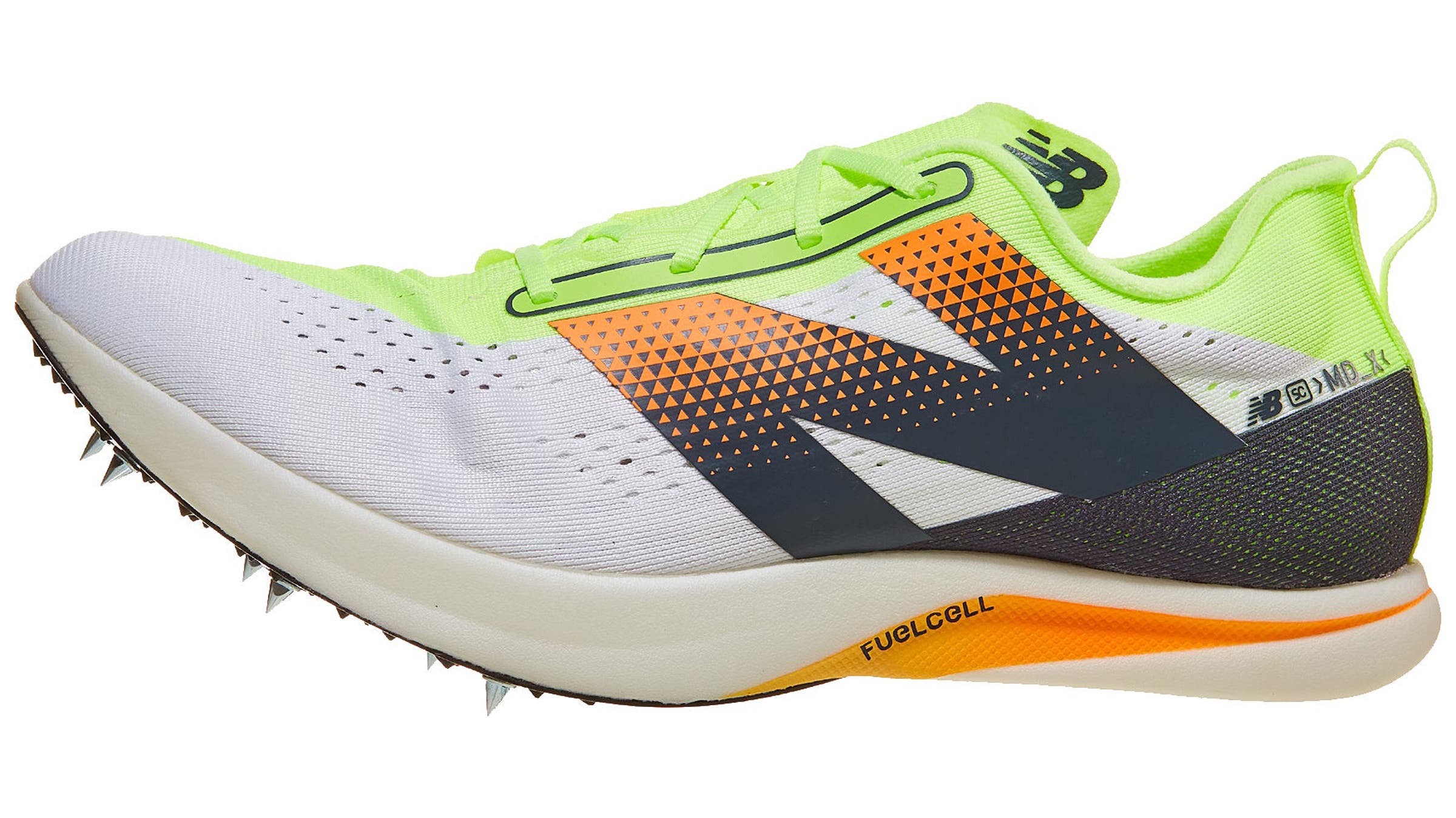
Runner Up All-Around
New Balance FuelCell SuperComp MD-X v3
Ideal Events: 400 to 5,000 meters
Weight: 6.2 ounces
Spike Pins: 6
We found the New Balance FuelCell SuperComp MD-X v3 shined at any distance from 400 meters to 5,000 meters. Combining the stiff, forward propulsion of a sprint track spike with the cushioning and comfort of a distance spike, it is one of the more versatile spikes on the market suitable for middle- and long-distance events. The 20-millimeter stack height of 100% PEBA foam underfoot is incredibly bouncy and provides a more cushioned feel than most middle-distance track spikes, while the steep forefoot rocker ensures there’s plenty of power during toe-off. A soft, lightweight, breathable mesh upper hugs the foot snugly, providing a glove-like fit that felt comfortable even without socks.
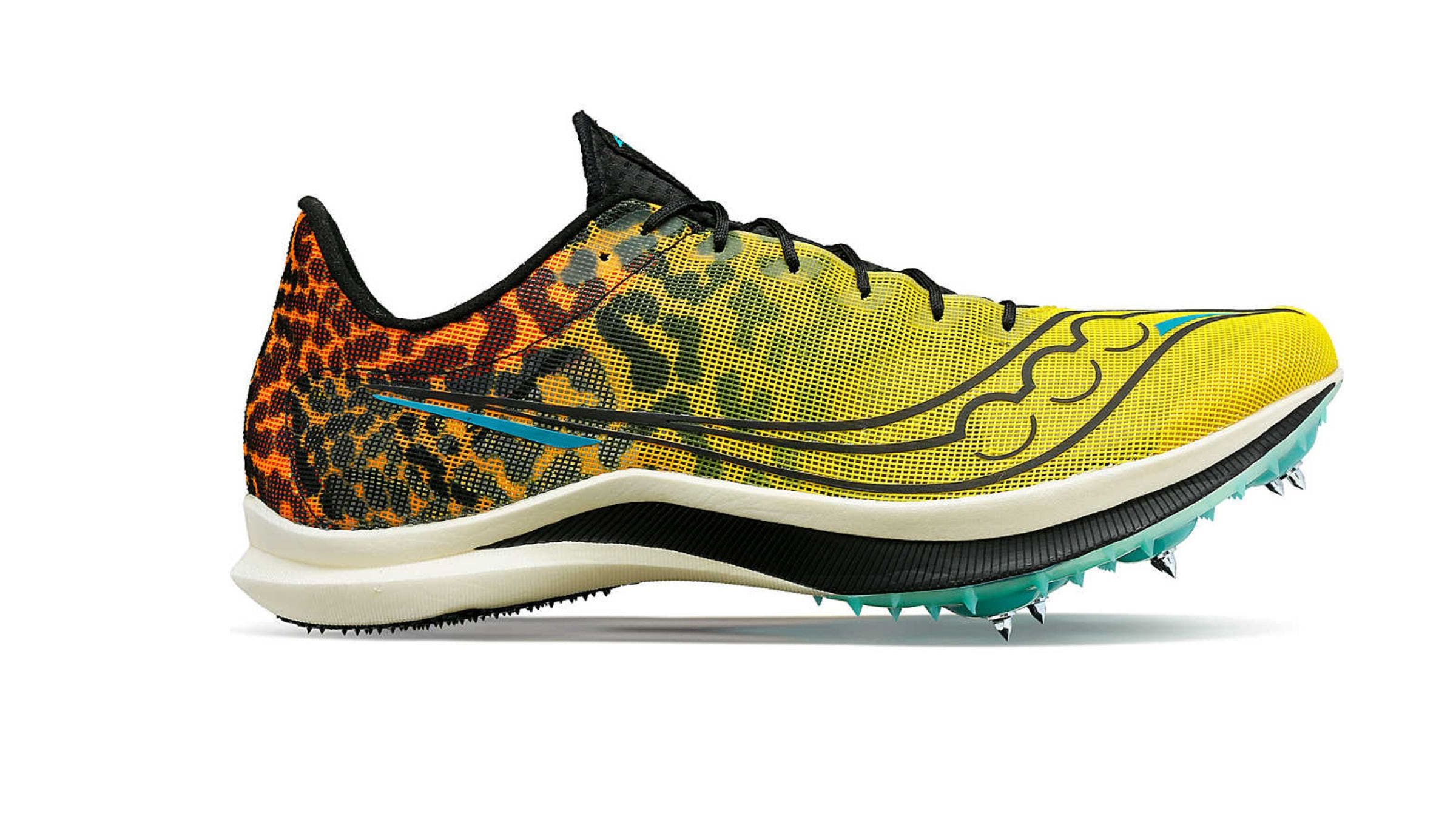
Lightest
Saucony Endorphin Cheetah
Ideal Events: 400 to 3000 meters
Weight: 4.2 ounces
Spike Pins: 6
The Saucony Endorphin Cheetah impressed our testing team more than any other spike we’ve seen in the last two years with its combo of comfort, power, and light weight. “Over short distances, I could maintain significantly higher velocity in this spike compared to others I tested,” raved one tester. An embedded, stiff carbon-fiber plate and a six-pin Pebax spike plate work harmoniously with a generous layer of extra-springy, PEBA-based, PWRRUN HG foam. “Every step was firm and powerful, with exceptional stiffness that maximized performance,” said another tester. These spikes, however, keep you on your toes, losing their magic if you can’t maintain a powerful, forward-balanced, forefoot stride. But those strong enough to handle its aggressive geometry could feel, as one tester reported, “like I was running on clouds,” and find that the Saucony Endorphin Cheetah is, as another tester claimed, “the fastest middle-distance spike on the market.”
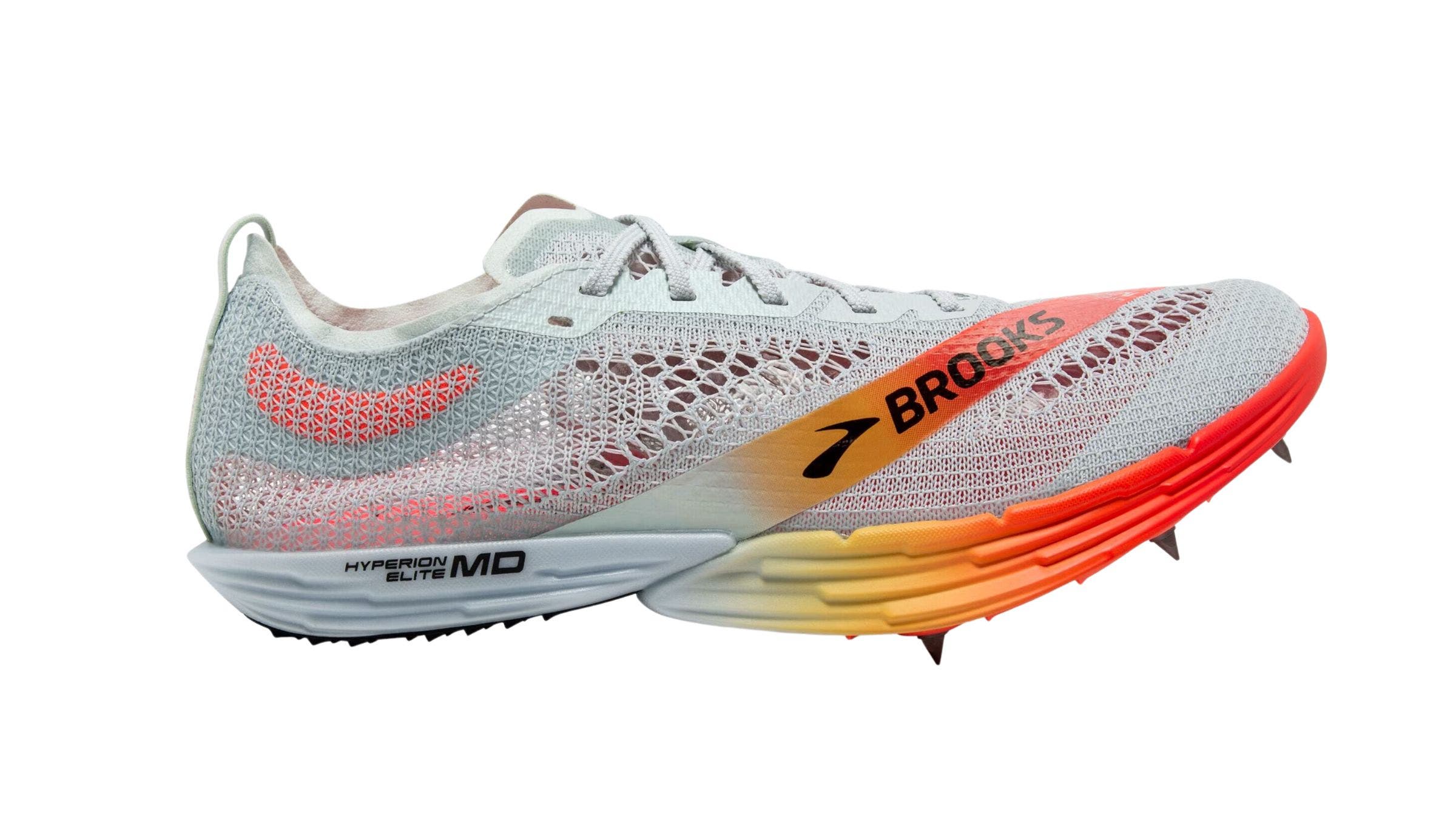
For Forefoot Runners
Brooks Hyperion Elite MD
Ideal Events: 800 to 3000 meters
Weight: 5.4 ounces
Spike Pins: 6
Designed to encourage a forefoot strike pattern, the Brooks Hyperion Elite MD is ideal for middle-distance runners seeking flexibility under the arch while still maintaining a stiff forefoot. This flex pattern pays dividends to runners with strong feet and a powerful toe-off in the form of a more sensitive, supple ride. With the cushioning strategically placed more in high-impact areas under the metatarsals and less under the heel, one tester observed, “This shoe urges me to get up on my forefoot and blast off.” Whenever he maintained this posture, he said the cushioning felt perfect. The upper is an extremely comfortable porous woven mesh that’s friendly enough on skin to run sockless.
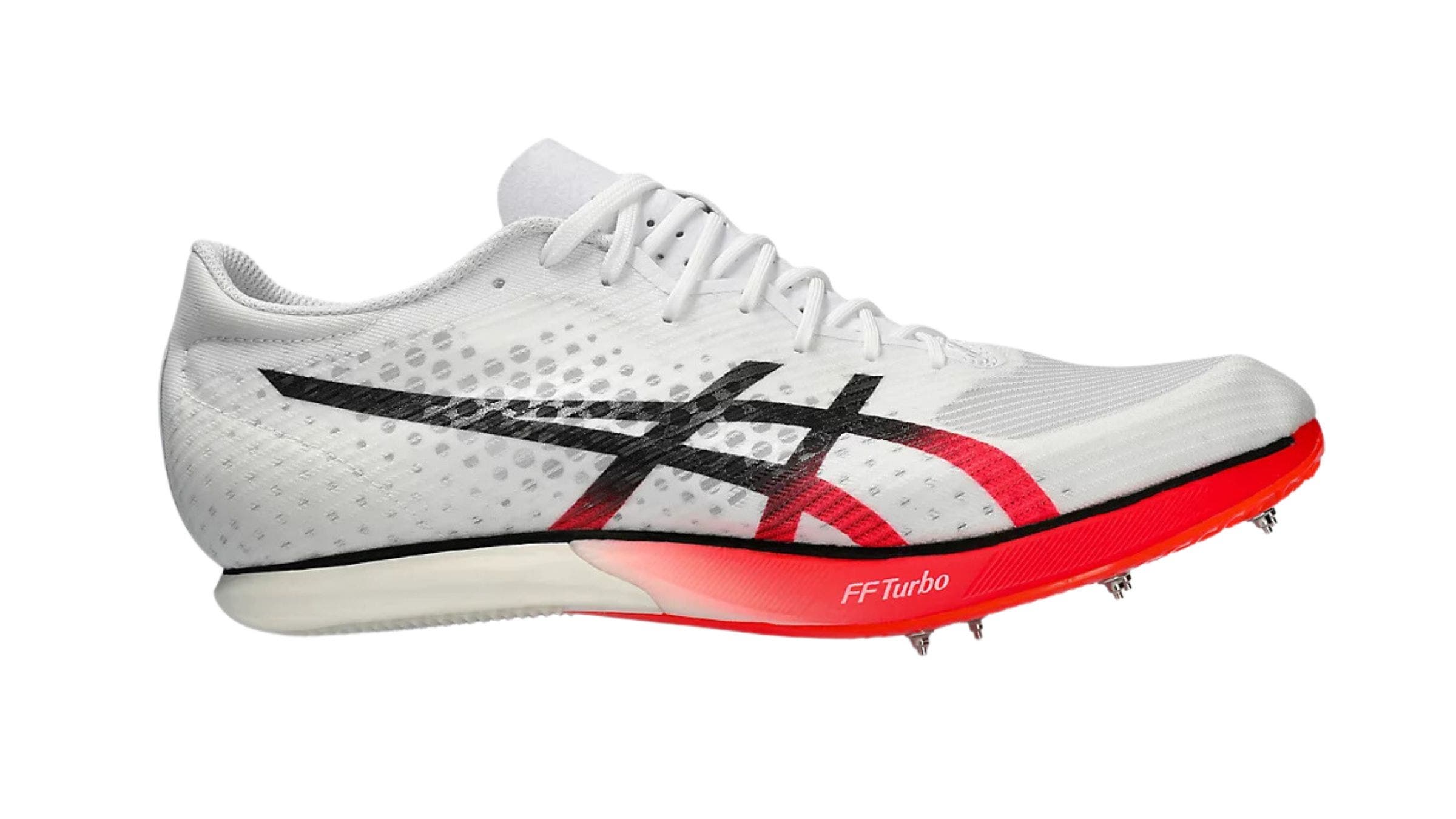
For Narrow Feet
Asics MetaSpeed MD
Ideal Events: 800 to 3000 meters
Weight: 5.9 ounces
Spike Pins: 6
The Metaspeed MD features both an embedded carbon fiber plate and a composite three-quarter length spike plate, providing a stiff and guiding sensation. “The feel isn’t entirely rigid—there’s a softness to the landing—but the aggressiveness of being on your toes is evident with every stride,” said one tester, who added, “With some knee drive and push-off, however, the Metaspeed MD feels surprisingly smooth with a sharp snap. Testers unanimously agreed that the shoe’s fit is long and exceptionally narrow, from the heel to the midfoot, with minimal to no arch support. This is great if you’re confident up on your toes, but it can lead to instability for those who aren’t. Some testers absolutely loved these spikes, with one setting a 400-meter PR in them, while two others struggled with the fit. We recommend these for runners with long and narrow feet who are comfortable running on their toes and prefer a stiff platform.
The Best Sprint Track Spikes

Best All-Around
Nike Max Fly 2
Ideal Events: 60 to 400 meters, hurdles
Weight: 6.6 ounces
Spike Pins: 6
Our preferred spike for all sprint events again this year, the Nike Max Fly 2 is every bit the super spike. Updated to be lighter and more responsive, its highlight continues to be the two-chambered pressurized Zoom Air unit in the forefoot that sits beneath a full-length carbon-fiber plate. Performance-wise, our sprint tester found them to be on par with the first Max Fly for the 100 meters, and better in the 200m. A flatter spike plate eliminates the instability of its predecessor, delivering “more confidence in each step, both on the straight and through the turns,” according to our sprint tester. Changes to the Nike Flyweave upper netted a more accommodating fit, particularly around the ball of our tester’s foot and the base of his pinky toe.

Most Aggressive
Puma evoSPEED Sprint Nitro 2
Ideal Events: 60 to 200 meters
Weight: 5.9 ounces
Spike Pins: 8 nonremovable
For powerful sprinters who want an aggressive spike that’s going to force them onto the balls of their feet, the Puma Sprint Nitro 2 is a top choice. Its stiff, spoon-shaped carbon fiber plate enables explosive toe-offs, making it ideal for experienced athletes who can handle its rigid sole and aggressive rocker. Underfoot, testers reported the full-length nitrogen-infused PEBA foam delivers a “springy and propulsive” feel. Nonremovable spikes help reduce weight (but are illegal at some meets). The breathable upper, reinforced with carbon fiber threads fits like a sock offering a secure yet comfortable hold.
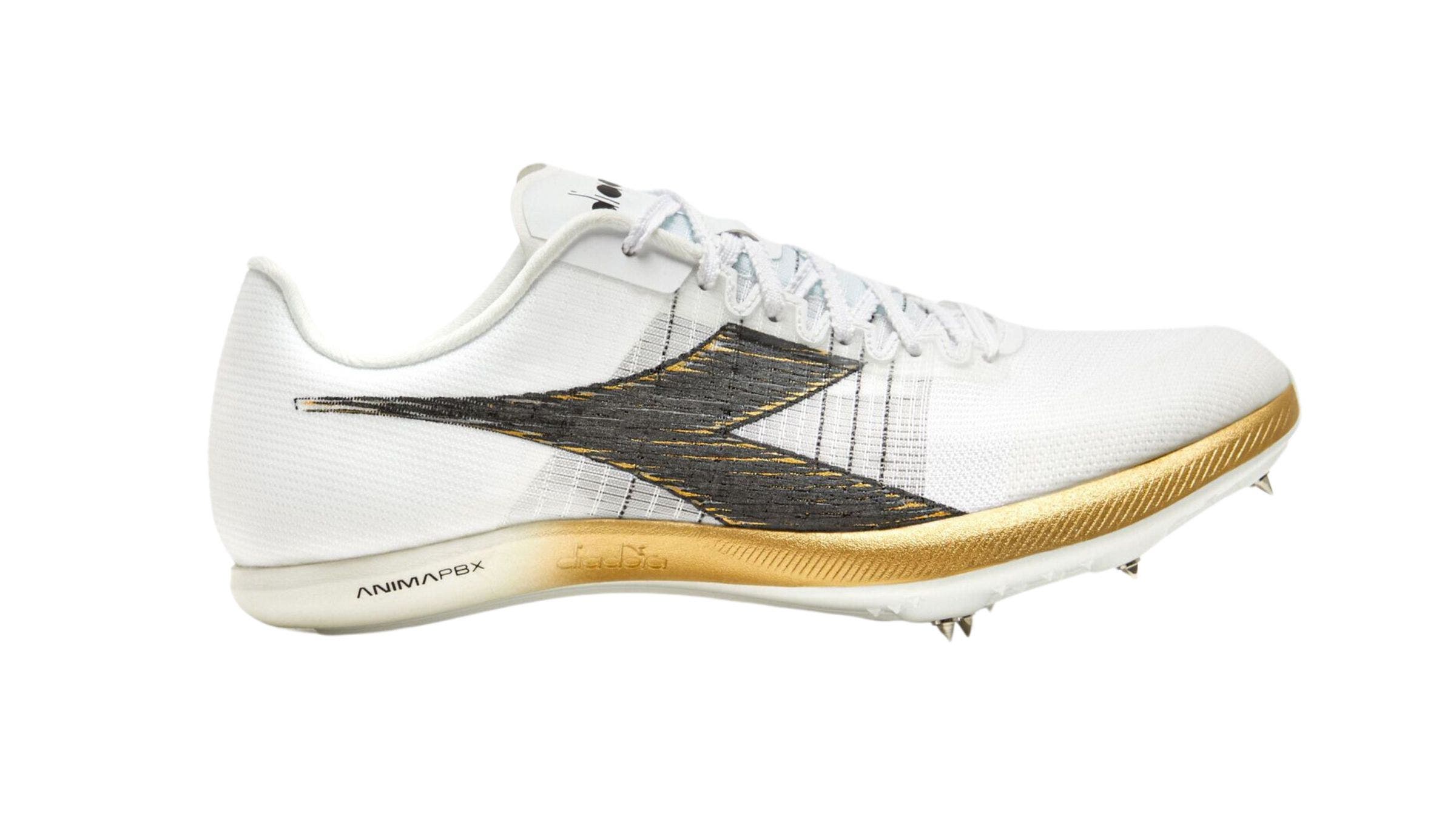
Most Versatile
Diadora Velocita Carbon
Ideal Events: 60 to 3000 meters
Weight: 6.3 ounces
Spike Pins: 7
Crafted with the precision of fine European dress shoes, these spikes offer premium materials and performance. Made by the venerable (founded in 1948) Italian athletic shoe brand, Diadora, the Velocita Carbon quickly emerged as one of the most versatile spikes we tested. Suitable for sprint and middle-distance events up to 3K, testers praised them for their comfort and more voluminous, accommodating fit. If you struggle to find a wide, higher-volume track spike, look no further. Underfoot, a thin layer of PEBA midsole is assisted by a stiff, curved, embedded carbon fiber plate. In terms of performance, this combo was “so reactive that I felt like I hardly had to put any effort into the sprint as the energy seemed to return each step I took,” exclaimed one tester after her track workout.
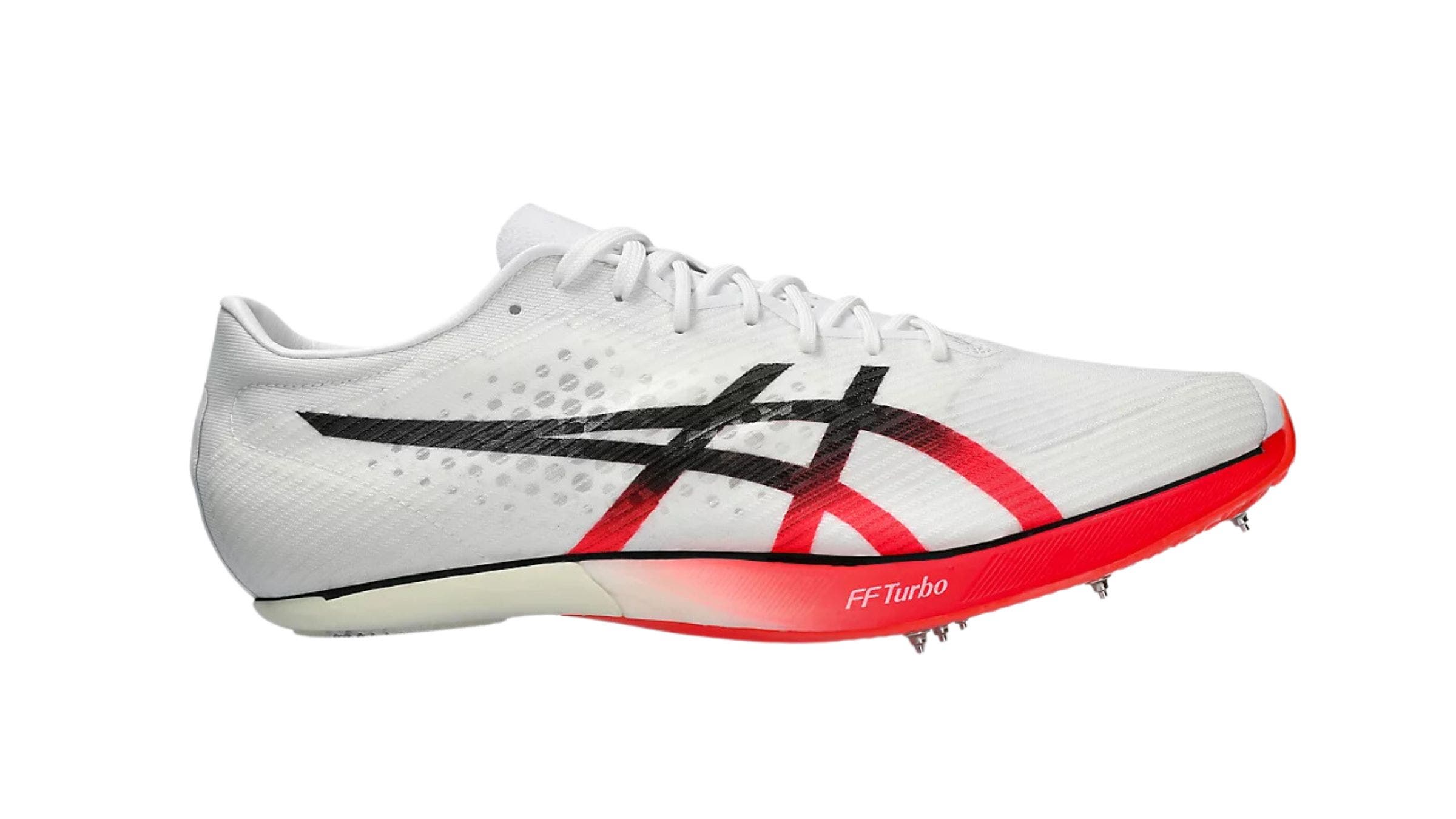
Best Ground Connection
Asics Metaspeed SP
Ideal Events: 60 to 400 meters, hurdles
Weight: 5.8 ounces
Spike Pins: 7
Suited for intermediate or advanced sprint and hurdle runners, testers praised the Asics Metaspeed SP for its comfortable-fitting, forward-slinging demeanor. Equipped with a thin layer of Asics’ FFBlast Turbo cushioning and an embedded stiff carbon fiber plate, our lead sprint tester described the Metaspeed SP as “quite stiff, yet not excessively harsh on the body.” The stiff plate resulted in a ride that felt like it was propelling him aggressively forward rather than bouncing vertically, which he reported lead to a longer stride length and faster paces. Another tester said, “My feet rolled forward with no effort at all.” Also appreciated was the breathable and comfortable upper, which one tester described as “supportive yet soft and breathable enough to wear without socks.”
The Best Value Spikes

Distance
Nike Zoom Rival Distance
Ideal Events: 400 to 5,000 meters
Weight: Unknown
Spike Pins: 4
Only some people need—or will even benefit—from pricey super spikes. For runners who want a versatile, reliable, well-made traditional distance spike, the Nike Zoom Rival is one of the best-value picks on the market. Taking learnings from Nike’s top-end Dragonfly, the new Zoom Rival features a slightly more aggressive rocker shape to help with toe-offs while also using lighter materials than the previous version to reduce overall weight. An external Pebax spike plate under the forefoot adds a touch of rigidity to maintain performance form, while still allowing a more natural flex than the Dragonfly to accommodate novice, less powerful runners. A full-length, energetic EVA midsole provides just enough cushioning to ensure a comfortable ride. A young high school runner focusing on anything over 400 meters can’t go wrong with this time-tested favorite.
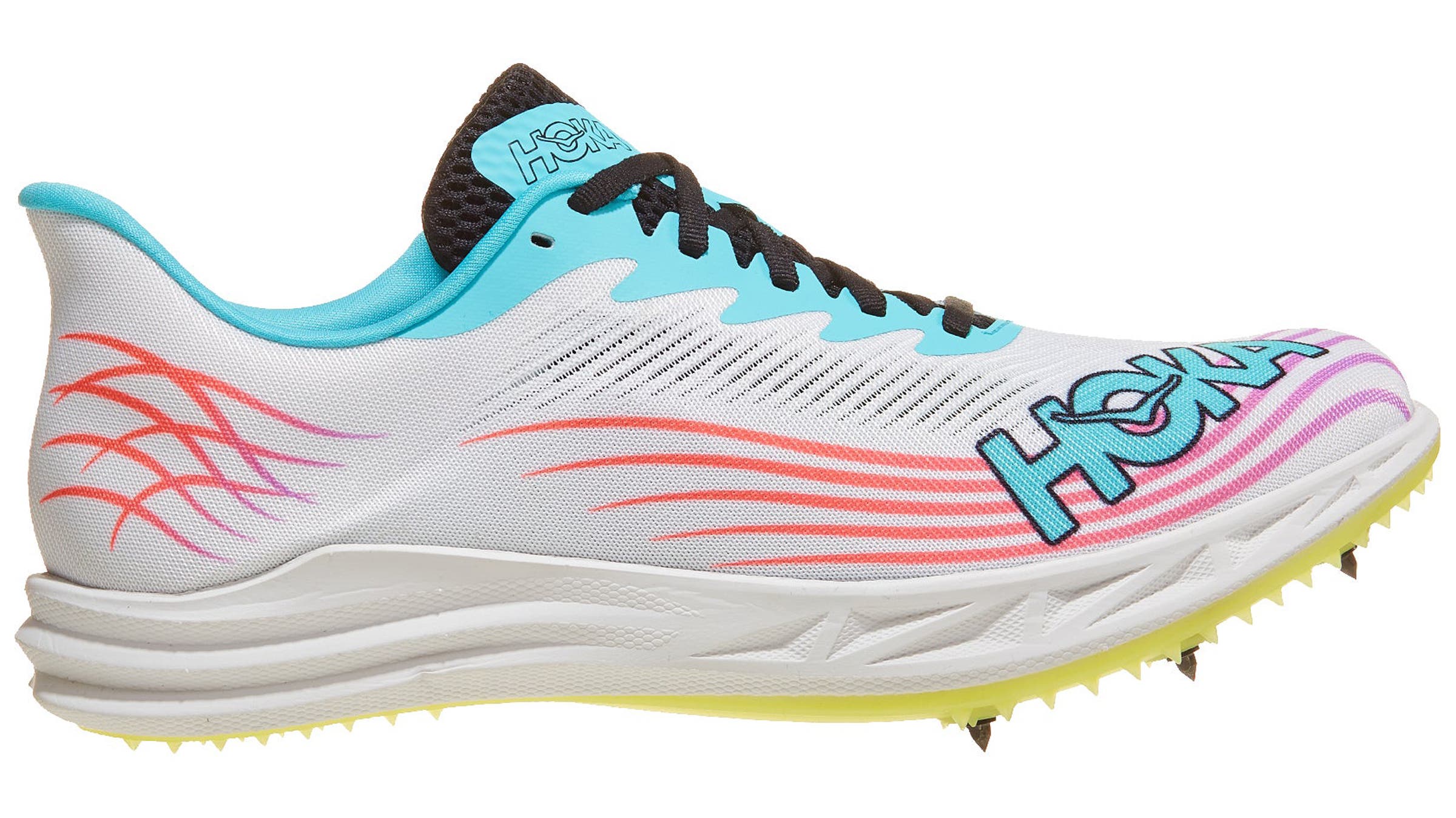
Middle-Distance
Hoka Crescendo MD 2
Ideal Events: 400 to 10,000 meters and cross country
Weight: 6.5 ounces
Spike Pins: 6
Now featuring a more streamlined and comfortable upper, the Hoka Crescendo MD 2 remains the most comfortable spike we tested—perfect for long track workouts, multi-event meets, and beginner track athletes. This is a spike you can wear all day. With a stiff, rockered Pebax spike plate under a thick stack of compression-molded EVA, the Crescendo MD 2 feels more like a lightly cushioned road racing flat with exceptional stability than a track spike. While it may not have the pop of more expensive super spikes, even our most experienced testers enjoyed the stable, buttery smooth ride it provided. Increasing their versatility, these also could double as a fantastic cross country spike.

Sprint
Under Armour Kick Sprint 4
Ideal Events: 60 to 400 meters, hurdles
Weight: 6.5 ounces
Spike Pins: 6
At less than half the price of high-end sprinting spikes, the Under Armour Kick Sprint 4 is an absolute bargain for novice and emerging sprinters. The three-quarter-length Pebax cleat plate delivers powerful propulsion without feeling too stiff and harsh, as many entry-level spikes often do. Credit the thin, one-piece layer of EVA-based midsole that softens powerful ground strikes and converts them into explosive takeoffs. Meanwhile, a breathable yet supportive synthetic mesh upper secures your feet like the cockpit of an F-16 fighter jet. Overall, these spikes offer comfortable padding, moderate stiffness, and considerable durability, making them a favorable option for high school athletes participating in sprinting or hurdling events.
How to Choose a Track Spike
Given the vast differences in how each spike feels and performs—even in various models from the same brand—and the snug, connected fit you want from a performance shoe, you have to try a spike on and run in it to evaluate whether it works for you.
But first, you need to determine which type of spike will work for your preferred events. Track spikes are divided into three categories: sprint (optimized for 60 to 400 meters), middle distance (400 to 3,000 meters), and long distance (3,000 to 10,000 meters). These distinctions are not absolute, and some runners may find a spike works well for them outside their intended event category.
Paul Lang, senior manager of footwear merchandising at Asics, explains that the distinction is based primarily on how they move with the foot. Sprint spikes, Lang says, “are built with a stiff spike plate, usually running the length of the shoe, to provide rigidity underfoot and promote power transfer and propulsion.” These stiff plates feature an aggressive forward-leaning geometry that helps sprinters stay on their toes. Sprinting spikes will also have a more structured upper than distance models. Lang explains that this locks down the foot to harness the incredible amount of power created by the sprinter’s explosive moments.
“A middle-distance spike,” Lang says, “maintains an aggressive geometry that helps the runner get to their midfoot for an efficient, powerful gait, but typically the plate will only run one-half to three-quarters of the length of the shoe, to allow slightly more flex and comfort over the multi-lap races.” The uppers tend to be light and flexible, prioritizing comfort and efficiency over power. Long-distance spikes tend to offer even more flexibility than middle-distance spikes and typically have more cushioning through the midsole for increased comfort during long track races.
After sorting out what type of spike you need, the choice comes down to fit and personal preferences on cushioning, stiffness, and geometry. Of these, sole rigidity seems to vary the most between spikes. Knowing whether you prefer a stiff sole or a more flexible one will go a long way in helping you find the ideal track spike. Typically, more experienced runners who stay up on their toes and push off powerfully will favor a stiffer and more curved spike.
“If you’ve never worn spikes before, find something that fits the foot comfortably and allows the feeling of natural movement,” Lang says. “If you’re not yet decided on an event group, a middle-distance spike is the most versatile and can be used across sprints, hurdles, jumps, and distance.”
What Is a Super Spike?
Many of our highlighted options fall into the category of super spikes, new models that are more comfortable than previous options and may enhance performance and reduce recovery times. What makes these shoes different from the minimalist spikes tracksters have worn for decades?
When designing a spike, Elliott Heath, footwear product manager for Nike Running, says that he and his team are always seeking the perfect balance between four main inputs: weight, cushioning, stiffness, and containment, which means how well the shoe holds the foot. Until recently, designers focused on making spikes increasingly minimal while retaining their ability to grip the track and secure the foot. The resulting thinly padded soles “beat up your body at the cost of performance,” Heath says. Stiff forefoot plates, incorporated into outsoles, served to generate more power by extending runners’ push-off.
In the past four years, however, big changes have happened around cushioning, Heath says. New foams have allowed designers to put more cushioning into track spikes without adding excessive weight. These new foams are not only lighter, they also rebound more effectively than ever before. So although you sink into the soles underfoot, you can still push off powerfully.
Taking cues from road-running super shoes, brands have created spike models with highly cushioned midsoles, combining new lightweight, energy-returning foams with embedded, curved plates that act in a novel way to stabilize and optimize the foam’s response. Enter the super spike.
Are Super Spikes Worth the Price?
High school, collegiate, national, and world records have all fallen since the advent of the new spikes, suggesting that they enhance performance, like their road-shoe counterparts. That said, scientific evidence on the spikes’ effect isn’t entirely clear. In a recent paper, researchers from the University of Massachusetts concluded that due to the more complex metabolic demands of track events, designing valid studies to quantify the benefits of spikes is more difficult than measuring the effect of marathon super shoes. Lacking such studies, it’s possible that recent fast times might also be due to other factors, like better training during the pandemic.
Even if we can’t say scientifically that super spikes will make you faster, they feel like they do. Scott Burns, head track and field coach at Downingtown West High School in Pennsylvania and an elite masters runner, believes that the investment is worthwhile for any experienced runner looking to optimize performance. Other testers unanimously agreed with Burns; all found a marked improvement in perceived performance benefits when wearing the more expensive spikes.
Yet possible benefits have to be balanced with the price tag and a runner’s ability. Super-spike technologies magnify imbalances as well as strengths, and they have the potential to negatively alter stride mechanics for those lacking stability, power, and foot strength. Novice or emerging runners, Burns says, may not find the expensive new spikes appropriate. Newer runners may want to race in lightweight training or road-racing shoes or opt for less expensive spike models made to be more accessible and forgiving.
How We Tested Spikes
To test this spring’s spike collection, we recruited a group of eight experienced male and female track runners, including sprint, middle-distance, and long-distance specialists. Over the course of one to three months, they tested this spring’s latest models from each major running brand in both track workouts and races ranging from 60 to 10,000 meters. Each runner then ranked each spike on a scale of one to ten and submitted a final report based on performance, fit, ride quality, and overall impression. We compiled the reports and compared them against last season’s best to tease out the best models in each category and gathered additional feedback on these models from other athletes to broaden the scope of the review process.